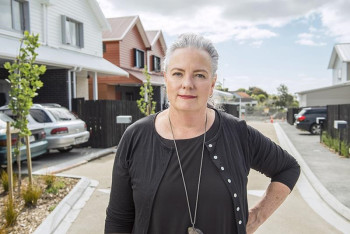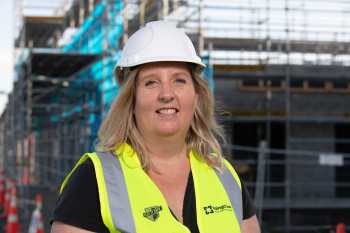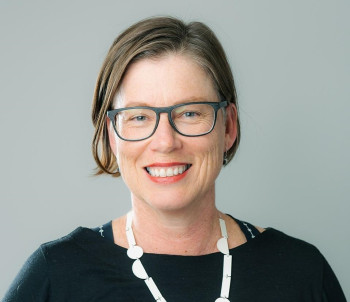Three women changing the face of construction
Today, Kāinga Ora is home to some of the most innovative minds in Aotearoa construction, including many women who have risen through the ranks and are helping to lead our organisation.
It’s no secret that the construction industry has traditionally been a male-dominated field, and women have had to work hard to secure their seats at the table. We chatted to three women at the top of their game — Sue Evans, Rohan Bush, and Jane Jujnovich — all recognised last year by peers for their innovation and achievements in their respective mahi.
How buildings help people thrive

Sue Evans is less interested in the detail of buildings, rather, in the spaces they inhabit and the role they play in helping people thrive; mahi requiring a diverse range of voices.
Sue Evans, Director – Urban Design in our Urban Planning and Design group, was one of five finalists for the 2023 Architecture+Women NZ Chrystall Excellence Award, a celebration of women who have led expanded and full careers in architecture over several decades. A major focus of this lifetime achievement award is recognition of excellence in a body of work, leadership, and contribution to the community through mentorship.
Sue says that the awards were established not only to honour women but to support, mentor and sponsor them to further their careers. This is mahi close to Sue’s heart in her role at Kāinga Ora, which includes supporting new starters in the Graduate Programme.
“As a mentor, we can give valuable advice. As a sponsor, we can support new graduates; paying them and growing them.”
Professional growth isn’t always linear. Sue herself says she has had a somewhat “unusual” career; first training in science as an undergraduate, before moving into teaching and youth work, then training in architecture and urban design. As such, Sue says she has developed a holistic view of urban design.
“I’m always supportive of helping young people into the design profession, especially encouraging young Māori, Pacific and other ethnicities. We need these voices in the profession, so we can see our rich society reflected in our built environment.”
Bringing colour and strength in numbers
Rohan Bush, Director – Building Sustainability Innovation and Standards in our Construction and Innovation group, was recently a finalist for Outstanding Leader of the Year at the National Association of Women in Construction (NAWIC) Awards for her contributions to the field of sustainability in the built environment.
Among other things, she helped establish the New Zealand Green Building Council and oversaw the development of the Green Star building rating.
“To walk into Te Pae Christchurch Convention Centre [for the NAWIC awards] and see a construction industry event absolutely full of colour, and expressions of the different ways women had dressed for the occasion — it was a noticeably different environment that I really enjoyed,” Rohan says.
“The night was a genuine acknowledgement of women and the careers they’ve had.”
Having joined NAWIC in 1998 as an architecture student, Rohan has seen first-hand the growth of both the organisation and the construction industry over the last two decades.
“Back then, there were hardly any members [in the committee] and it really felt like hard work. So, to go to this event where there were 600 people — it’s just amazing to see the progress that the industry has made over the last two or three decades,” Rohan says.
Te Mātāwai: Sign of the future

Jane Jujnovich recalls a “hilarious” epiphany while constructing Te Mātāwai: “It’s hilarious that we’d get super-excited when there were three women in key on-site subbie roles at Te Mātāwai. I mean, we’ve got 300 sub-contractors, and for us to be excited that there are three women definitely shows there is still work to be done.”
Jane Jujnovich, Project Director, Greenfield and Complex in our Urban Development and Delivery group has seen the same increase in the number of women throughout the industry.
“It has been great to see roles for women on the front line, in offices, and on construction sites have increased considerably over the last ten years.”
Jane was recently recognised with the James Hardie Innovation Award at the New Zealand Building People Awards for her hard mahi as Project Director of our Te Mātāwai development in Tāmaki Makaurau.
The groundbreaking development involved many women in key roles, inspiring not only the team on-site but the next generation of construction professionals.
“We had a woman-heavy team, which was awesome. For a long time, our senior architect, our façade engineer and our Geotech person were all women, so one of the things we did was a series of engagements with Auckland Girls’ Grammar to really try and encourage girls to think about the construction industry as an option.”
During a “speed dating day,” over 120 young women explored 10 different stations set up at the school, each with a specific focus and a person who played a role in Te Mātāwai.
This was a valuable engagement resulting in positive feedback and even work experience opportunities – and it seems this message of opportunity is getting out there.
“A genuine shift in what’s possible.”
When reflecting on the NAWIC awards, Rohan says there were lots of young women present on the night, some even acknowledged through specific awards for apprentices, students, and rising stars.
“It’s exciting to see the young women coming through. You could see at the awards a lot of these young women formed their own connections in the industry and were supporting each other. It really did feel like a genuine shift in what’s possible.”
Jane has also felt the industry transform before her eyes throughout her time in the public service, noting there are some great organisations around providing mentorship and support, as well as programmes within Kāinga Ora to empower the professionals of tomorrow.
“Our Graduate Programme is amazing, and I’m lucky enough to be a mentor for one of the graduates. She is super awesome and brings great new ideas and a different flavour to what we do.”
Combatting imposter syndrome
Rohan says mentorship helps to counter the imposter syndrome — self-doubt around skills or achievements —felt by many women in professional roles. A recent KPMG study found that 75% of female executives across industries had experienced imposter syndrome in some capacity.
Rohan says younger women often raise the topic with her. “I think it’s important to have someone who has been in the industry longer who you can ask those questions of without undermining your career.”
I’ve noticed a cultural shift towards being able to be vulnerable and bringing our whole selves to work. The idea of the ideal employee and the ideal leader is being challenged across all industries, but in particular, the construction space.”
Sue says that sometimes it’s as simple as visibility.
“I think just being there as a female leader in this profession is really useful so that younger women can see somebody doing this work that looks like them.”
“Culture beats everything.”

If people are shining, let them know, Rohan Bush says. “I love calling out people’s awesome work. When people do good work, just give all the credit back to them.”
Modelling authenticity is important in a leadership role, Sue says and is key to driving culture, which is critical to the success of any organisation.
“Culture beats strategy, culture beats processes, culture beats systems — it beats everything. When our people feel valued or connected to their programme, that’s when you get the best from them.”
In Rohan’s team, a culture of conversation is encouraged.
“I really value listening to people. Hierarchy is important in the context of an organisation, but it shouldn’t get in the way of who should contribute," she says.
“Where I see there are people wanting to contribute, I create the space for them to do that, and step back. If there are people who want to shine, give them the space to shine.”
The mahi is only beginning
Rohan would also like to acknowledge that for many women, progression isn’t as simple as moving up the ladder and that there is plenty of work to do regarding diversity and inclusion.
When asked what advice she’d give to women aspiring for leadership in the industry, Rohan’s answer was clear — back yourself.
“Put yourself forward, and don’t limit yourself. This is something women do — we see that men push ahead, and someone else limits them, but women will often do it for themselves, which is linked to the imposter syndrome. If there’s an opportunity to contribute, put your name in the ring. If you bring something to the table, people will want to keep working with you.
There is so much work to be done in this organisation — we need good people to step up and say they want to be a part of it.”
